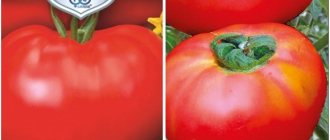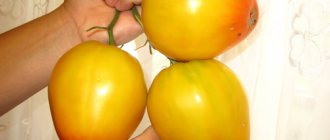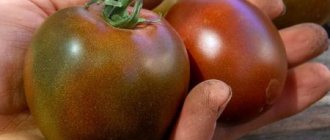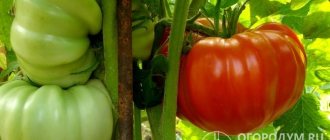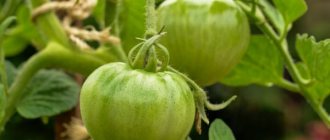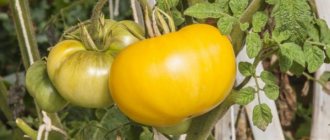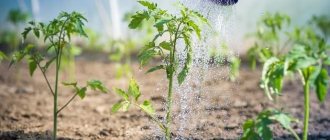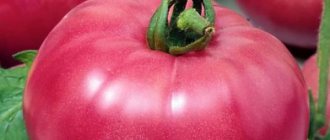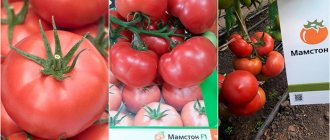Rules for collecting and storing tomatoes
The rules for growing seedlings are the same, whether for further planting in a greenhouse or in open ground.
Planting is carried out in seedling boxes filled with nutritious soil mixture. It can be purchased in the store. Grooves 10 mm deep are made in the ground, and seeds are laid out in them at intervals of 10 mm. They are sprinkled with earth on top, watered and covered with film. The box is located in a warm, dark place. With the emergence of seedlings, the film is removed, and the seedlings are transferred to a well-lit place with a slightly lower temperature.
When the seedlings grow two true leaves, they are planted in separate containers with a volume of at least 500 ml. This is necessary so that the powerful root system has space to develop.
The seedlings are watered as the soil dries out and fed once, shortly before planting in the ground.
In the garden bed where the tomatoes will be planted, the soil is cleared of weeds and residues of other plants. The soil is checked for pests. If the soil is slightly loose and does not retain moisture well, you need to add perlite and vermiculite. The soil must be nutritious and neutral in acidity, so organic matter, peat and wood ash are added. You can also add sand.
Important! When planting tomatoes in open ground, the bed is prepared in the place where the following crops previously grew: cucumbers, zucchini, pumpkin, cabbage, carrots, squash. The fruits ripen 110–120 days after planting
It is better to collect them at the stage of technical ripeness, so that they can lie until late autumn, ripening gradually. They need to be stored in a dark, cool place, away from other vegetables that can speed up the ripening process.
The fruits ripen 110–120 days after planting. It is better to collect them at the stage of technical ripeness, so that they can lie until late autumn, ripening gradually. They need to be stored in a dark, cool place, away from other vegetables that can speed up the ripening process.
We invite you to read: CO2 in the greenhouse and grow box or the benefits of using CO2 for plants
Gigant Novikova tomatoes, although they grow very large, have an excellent, juicy, sweet taste. They are great for fresh consumption, and preserves prepared with them will become the highlight of your table.
How to grow seedlings
Seeds for seedlings are sown 2 months before planting in the ground . They are pre-prepared to improve immunity and germination percentage.
Seed preparation
Seed material can be collected independently from large and healthy fruits. But in this case, special attention should be paid to preparing for sowing :
- Rejection. The grains are laid out on the table one at a time and carefully inspected for visible damage. Healthy specimens should be light in color and free from distortion.
- Checking for filling. Dissolve 1 teaspoon of salt in a glass of water and leave the grains in the solution for 10 minutes. Empty seeds will float to the surface. They will not sprout, so they are immediately disposed of.
- Disinfection. 1 g of manganese is dissolved in 0.5 cups of water, obtaining a weak (pink) solution. The grains are kept in it for 20–25 minutes, then washed with running water.
- Treatment with a growth stimulant to increase germination. The seeds are soaked for 10 hours.
Reference. The solution of potassium permanganate must be weak, otherwise a high concentration will ruin all the seed.
Container and soil
The soil for tall tomatoes is prepared from garden soil, humus, peat and river sand . All components are taken in equal proportions and mixed thoroughly. For fertility, add superphosphate or a full complex of minerals.
The finished soil is spilled with a hot solution of dark manganese to destroy pathogenic flora. There are many pathogenic spores in the ground that can cause great harm to seedlings. After the soil has cooled, it is laid out in planting containers.
Plant in a common wooden box or a separate container - paper honeycombs, plastic cups and peat pots. The containers are pre-treated with a manganese solution and drainage holes are made at the bottom of each to allow excess water to drain. Without drainage, when moisture stagnates, young roots can rot. In addition, with high humidity there is a risk of fungal infections.
About other giants for your garden:
Sowing
Furrows are made in the soil 2 cm deep, into which the seeds are planted . After the groove is covered with earth, compacted and watered with warm, settled water from a spray bottle. To create a greenhouse effect, containers are covered with film or glass and left indoors at a temperature of 24–26 °C.
Seedling care
When shoots appear, the film is removed , moving the containers to the windowsill. In the first week, the temperature is reduced to 16 °C. After a week it is raised to 22 °C.
The duration of daylight hours is at least 12 hours. If there is a lack of natural light, phytolamps are installed.
Reference. With insufficient lighting, seedlings noticeably lag behind in development.
During the seedling period, moderate watering is necessary only with warm, settled water from a shallow watering can. After watering, the soil is carefully loosened.
When two true leaves form, the seedlings are picked and placed in separate containers. Before the procedure, the soil is well moistened and replanted along with a lump of earth. The soil into which the transplant is made is fertilized with a full range of minerals.
2 weeks before transplanting, seedlings are hardened off in the open air . On the first day, the time spent outside is no more than 1 hour, and the temperature is not lower than 16 °C. Gradually the time interval is increased to 11 hours.
Description of fruits
Now let's move on to the most interesting part - the description of the royal fruits. And the fact that they really deserve such a title is proven by numerous reviews from those who planted this variety on their site.
The fruits of the King of Giants are large, bright red, slightly flattened. Weight – 500-600 grams, there may be heavier specimens – up to 800 grams. If you leave only two or three ovaries in the bunch, you can get a tomato weighing a whole kilogram.
The pulp is fleshy, juicy, and the taste is excellent. Typically the fetus has 8 chambers. The skin is dense and does not crack even on very large fruits. This tomato has a high content of vitamins, and therefore experts advise using the King for dietary and baby food.
Many people note the amazing sweetness of the fruits of the variety, so if you want a large-fruited sweet tomato, choose the King of the Giants. At the same time, it is good fresh, great for making sauces and salads. But those tomatoes that ripen later will not be as large as the first ones, and they can be canned or salted.
This tall variety is characterized by keeping quality and is suitable for transportation.
With proper care, the yield reaches approximately 7-8 kg per square meter. In the southern regions, the figures may be higher, but it all depends on the care and growing conditions.
Biological features and specifics of cultivation of the variety
Tomato of “folk selection”. Widely distributed, but not registered. Seeds are sold by Agro, Siberian Garden, Veles and others.
Unfortunately, in the descriptions provided by manufacturers on the packaging, there are contradictions regarding yield, as well as the color and maximum weight of the fruit. When assessing these parameters, it makes sense to rely solely on the information of those who planted the tomato.
Laboratory testing of seed quality can be seen in the following video:
The variety is intended for cultivation in open and protected ground (depending on climatic conditions). Plants are indeterminate, tall (up to 200 cm or more).
The activity of side shoot formation is assessed by vegetable growers as average. However, the optimal method of cultivation is considered to be cultivation with the formation of a bush into one trunk.
The variety is characterized by an extended fruiting period, so you can take your time pinching the stems (if the seedlings are planted in a bed or in a high enough greenhouse) to give the plants the opportunity to form ovaries for as long as possible. The bushes need to be tied to supports. In addition, it is necessary to remove all leaves growing below the first flower cluster to reduce the likelihood of disease.
According to vegetable growers, tomato is highly sensitive to the mineral composition of the soil. During the growing season, plants need to be fed at least 3 times. The variety is relatively weakly affected by diseases, but bushes are often damaged by caterpillars of armyworms, whiteflies and other insects.
The average fruit ripening period is 110-120 days from the appearance of full shoots. Each bunch produces 4-5 tomatoes weighing an average of 500-600 g.
Some summer residents report that when rationing the number of ovaries, it is possible to grow specimens weighing from 1000 to 1300 g.
The fruits have a flat-round shape with pronounced ribbing and a rich crimson color. The skin of tomatoes is not very durable and is prone to cracking. The pulp is sugary, juicy, aromatic, of excellent taste. The fruits are great for summer salads, processing into juices and sauces, but when ripe they are almost not stored and are not suitable for transportation.
Seed producers promise the variety's yield from 6 to 9 kg per plant. The experience of gardeners indicates that this parameter, even under good weather conditions and competent agricultural technology, does not exceed 4 kg.
Features Overview
Studying the “Giant Novikova” tomato, the characteristics and descriptions of the variety from different manufacturers do not differ at all in terms of ripening time and vegetative form. Tomatoes are medium in ripening and are intended for growing in greenhouses and hotbeds
Description of the bush
The plant is indeterminate, tall. The shoot height reaches two meters. The leaf blade is medium in size and the shoot itself is not very leafy.
The bush requires constant stepsoning, but does not show abundant formation of stepsons.
Each brush carries 4-5 large tomatoes.
A salad variety with the possibility of processing into juices, purees, pastes, and ketchups. All companies present the tomato as a very large-fruited one. The size of a tomato is described on average as 600 g, but Aelita insists on 1200 g; Siberian Garden claims that a tomato can reach 1500 kg in weight.
Manufacturers also did not agree on the color scheme: “Veles claims that the tomato is pink, “Aelita” and “Seeds of Crimea” describe the tomato as raspberry, “Siberian Garden” speaks of a pink-raspberry color.
How to grow tomatoes
Replanting is carried out when the soil warms up to 15 °C. In cold soil, young bushes will not grow for a long time, and the root system can rot in the cold.
Landing
Beds for tomatoes are chosen in a sunny place, protected from draft winds. If planting is planned in a greenhouse, the soil must first be spilled with copper sulfate to destroy fungal spores.
The soil is dug up, a complex of minerals is added and holes are made no deeper than 20 cm. A little wood ash is placed at the bottom of each hole and filled with warm water. For 1 sq. m place 2-3 seedlings at a distance of 60 cm from each other. When planted in a checkerboard pattern, the plants will not shade each other and will be able to ventilate.
Further care
Regular watering is established as the seedlings take root in a new location. Water once every 10 days, on hot days - once a week. To retain moisture, the beds are mulched with peat, straw or sawdust.
This is especially important on dry days when there is a lot of evaporation
The culture responds well to drip irrigation. To do this, place a plastic bottle without a bottom in the root zone and fill it with water, which gradually penetrates from the bottle to the roots. After watering, the soil is loosened and weeds with roots are removed.
Tall seedlings require frequent feeding with a full range of minerals. Feed once every 2 weeks, alternating the addition of minerals with organic compounds. From organic matter, mullein infusion is used in a ratio of 1:10. It ensures soil fertility, and minerals nourish the root system.
Features of cultivation and possible difficulties
To secure the seedlings, trellises are made in advance. Metal supports are installed on different sides of the beds and a wire is stretched horizontally between them. The stem and fruit-bearing branches with heavy fruits are fixed to it. A garter on a trellis is the most convenient option for fixing tall plants, so the seedlings are not injured at all.
To get maximum results, the bush is formed into 1 or 2 stems. All other stepsons are removed. There are few side shoots, but if they are not removed, they thicken the plantings. The lower leaves are removed before the first fruitful branch, since if they come into contact with wet beds, they will rot, which will lead to the development of infections.
Diseases and pests
The culture has proven itself to be highly resistant to diseases of the nightshade family. Therefore, after prevention, the seedlings do not get sick throughout the entire growing season. This includes moderate watering, systematic loosening, mulching the beds and treating plants with fungicidal agents, for example, Fitosporin. Among other things, it improves plant immunity.
Tomato is less resistant to pests. It suffers from attacks from the Colorado potato beetle, armyworm, aphids and slugs. A soap solution is used against aphids and slugs, which is used to treat the stems of seedlings. The Colorado potato beetle is collected by hand along with its larvae, which the female lays on the back side of the leaf.
Therefore, it is important to inspect the seedlings carefully and from all sides. A decoction of wormwood helps in the fight against cutworms: boil 1 kg of wormwood in 3 liters of water.
Apply twice with an interval of 1 week.
When growing tomatoes in a greenhouse, it is ventilated every day so that the level of humidity and temperature does not exceed the norm.
Landing
Seeds for seedlings are sown in the last days of February or early March. If there is insufficient illumination, additional illumination must be done artificially. Usually it is ready for transplanting into a greenhouse within two months from the moment of sowing.
Sowing
The fruits are characterized by excellent taste
Seed preparation includes disinfection with a manganese solution and treatment with a growth stimulant.
A layer of soil fertilized with a mineral complex is poured into the tray and the seeds are laid out on it (every 1.5-2 cm).
Tatyana Orlova (Vasilidchenko) (candidate of agricultural sciences):
If ready-made soil is used for sowing seeds, no additional mineral and organic fertilizers are required. The soil is completely ready for use.
Using a spray bottle, they are moistened with warm water and covered with a second layer of soil 1 cm thick.
The tray is covered with film until the first shoots appear, and the temperature is set to 24-25°C.
Seedling
According to the description, shoots appear in 4-5 days - from this moment the film is removed. The hatched sprouts are carefully watered with warm water.
The tray is transferred to the windowsill, the temperature is lowered to 18 ° C (for one week). When 2 true leaves become clearly visible, you can plant the seedlings into separate containers.
During the procedure, mineral fertilizers are again added to the soil.
Transfer
Two weeks before transplantation, the hardening process begins: the seedlings are taken out onto the street or balcony every day, gradually increasing the time of their stay.
The soil in the greenhouse is treated with a manganese solution, fertilized, and loosened. Install a trellis for tying up tall bushes. Plants are planted at a distance of 60 cm from each other.
Tall bushes need pinching and staking. They are formed into 1-2 stems, removing side shoots and pinching off the growing point.
The lower leaves are regularly cut off (2-3 pieces at a time) so as not to thicken or shade the plantings. Since the fruits grow very large, it is necessary to tie up not only the stems, but also the fruit clusters. (It has been noticed that when a branch is broken, the set fruits cannot ripen.)
The bed is watered once every 10 days, strictly at the root, with warm water (in hot summers, more often - once a week).
Alternatively, you can install drip irrigation.
To avoid late blight and rot, the greenhouse must be regularly ventilated. After watering, the soil is loosened, and as weeds appear, they are weeded. The beds can be mulched with dry grass or peat, which will retain moisture in the soil and make maintenance much easier.
Video
If you are interested in the topic of the article, you can get acquainted with the opinion of an experienced vegetable grower about the “Giant Novikova” tomato variety in the following video:
About the author:
Found a mistake? Select the text with the mouse and click:
Ctrl + Enter
Do you know that:
A new product from American developers is the Tertill robot, which weeds weeds in the garden. The device was invented under the leadership of John Downes (creator of the robot vacuum cleaner) and works autonomously in all weather conditions, moving over uneven surfaces on wheels. At the same time, it cuts off all plants below 3 cm with the built-in trimmer.
It is believed that some vegetables and fruits (cucumbers, stem celery, all varieties of cabbage, peppers, apples) have “negative calorie content,” that is, more calories are consumed during digestion than they contain. In fact, only 10-20% of the calories received from food are consumed in the digestive process.
Convenient Android applications have been developed to help gardeners and gardeners. First of all, these are sowing (lunar, flower, etc.) calendars, thematic magazines, and collections of useful tips. With their help, you can choose a day favorable for planting each type of plant, determine the timing of their ripening and harvest on time.
Compost is rotted organic remains of various origins. How to do it? They put everything in a heap, hole or large box: kitchen scraps, tops of garden crops, weeds cut before flowering, thin twigs. All this is layered with phosphate rock, sometimes straw, earth or peat. (Some summer residents add special composting accelerators.) Cover with film. During the process of overheating, the pile is periodically turned or pierced to bring in fresh air. Typically, compost “ripens” for 2 years, but with modern additives it can be ready in one summer season.
In Australia, scientists have begun experiments in cloning several varieties of grapes grown in cold regions. Climate warming, which is predicted for the next 50 years, will lead to their disappearance. Australian varieties have excellent characteristics for winemaking and are not susceptible to diseases common in Europe and America.
Oklahoma farmer Carl Burns developed an unusual variety of multi-colored corn called Rainbow Corn. The grains on each cob are of different colors and shades: brown, pink, purple, blue, green, etc. This result was achieved through many years of selecting the most colored ordinary varieties and crossing them.
Humus is rotted manure or bird droppings. It is prepared like this: the manure is piled up in a heap or pile, layered with sawdust, peat and garden soil. The pile is covered with film to stabilize temperature and humidity (this is necessary to increase the activity of microorganisms). The fertilizer “ripens” within 2-5 years, depending on external conditions and the composition of the feedstock. The output is a loose, homogeneous mass with a pleasant smell of fresh earth.
“Frost-resistant” varieties of garden strawberries (more often simply “strawberries”) need shelter just as much as ordinary varieties (especially in those regions where there are snowless winters or frosts alternating with thaws). All strawberries have superficial roots. This means that without shelter they freeze to death. Sellers’ assurances that strawberries are “frost-resistant,” “winter-hardy,” “tolerates frosts down to −35 ℃,” etc. are deception. Gardeners must remember that no one has yet managed to change the root system of strawberries.
Both humus and compost are rightfully the basis of organic farming. Their presence in the soil significantly increases the yield and improves the taste of vegetables and fruits. They are very similar in properties and appearance, but they should not be confused. Humus is rotted manure or bird droppings. Compost is rotted organic remains of various origins (spoiled food from the kitchen, tops, weeds, thin twigs). Humus is considered a higher quality fertilizer; compost is more accessible.
leave a comment
Features of caring for tomato crops
The Giant Novikova tomato is very demanding to care for. Without following all the rules, you will not get a good harvest.
Irrigation rates
The first time the plant is watered immediately after planting in the ground, and very abundantly. Then they don't bother him for two or three days. All subsequent waterings are carried out at intervals of 3-4 days (adjustments are made depending on weather conditions). While the bush is young, 2-3 liters are enough for it; An adult plant needs at least 10 liters. The water should be warm.
Did you know? In 1776, when the northern colonies of England were actively fighting for their independence, George Washington's cook decided to poison him. He prepared a magnificent roast and garnished it generously with tomatoes, seriously believing that this vegetable was poisonous (in those days this was considered a well-known fact). Being completely confident in the outcome of the matter, he even wrote a corresponding report to the commander of the English royal troops.
Top dressing
During the entire growing season, the crop must be fed three times:
- The first time fertilizer is applied a week and a half after planting the seedlings in a permanent place. Nitrogen mixtures or organics with a high nitrogen content are used.
- The second feeding is carried out at the beginning of the flowering period. Superphosphates and potassium monophosphate are added. The dosage is calculated according to the instructions given on the package.
- The last time the bush is nourished is when the ovary appears on it. It is advisable to use nutrient mixtures to increase yield.
Stepping and bush formation
Since the fruits of the Giant Novikov are very large, it is necessary to normalize the ovary. It is recommended to leave 3-4 ovaries on the lower hands. The lower foliage covering the stem below the first cluster is also removed. This will reduce the likelihood of illness.
We advise you to read how to properly plant tomatoes in open ground.
The formation of the bush is carried out in 2-3 stems, but there is no need to rush to pinch all the shoots. The variety is characterized by a long fruiting period, so it is necessary to leave room for the formation of late ovaries.
The bushes are tall, so they definitely need staking.
Weeding the soil
Loosening and weeding of the soil is carried out along with watering. Only the thin top layer is fluffed up so that a crust does not form, preventing air exchange.
Diseases and pests of the variety
The Gigant Novikova variety was bred to be resistant to various ailments. Nevertheless, preventive measures must be carried out. A week before planting the seedlings in a permanent place, the soil is treated with a 5% solution of copper sulfate. A weak solution of potassium permanganate is poured into the holes when planting (2 g per 10 liters of water).
If the soil is very waterlogged and loosening is not carried out in a timely manner, then the plant may be damaged by root rot. If a problem is detected, the number of waterings is reduced, the soil is loosened generously and raked away from the bushes. Peat mixed with sand and fine sawdust is poured in its place.
If tomato beds are located close to potato beds, the Colorado potato beetle can be found on them. To destroy it, the insecticide “Prestige” is used.
Did you know? Tomatoes
- the most popular vegetable crop in the United States. It grows on 93% of the total number of private gardens.
Diseases and pests
The Giant Novikova tomato has complex resistance to fungal diseases. The only thing to be wary of is diseases associated with improper care. To avoid such difficulties when growing, you need to regularly ventilate the room where your tomatoes are growing and follow the watering and lighting regime.
The plant also often suffers from root rot, which is combated by loosening and reducing watering. The soil around the plant is raked and a mixture of peat, sand and fine sawdust is added instead. Among the harmful insects it can be affected by the potato bollworm, they fight against it by loosening, removing and destroying affected fruits and plants.
In the southern regions, the Colorado potato beetle can harm this species, especially in the southern regions; the “Prestige” product is successfully used against it. Among the pests that are most capable of causing harm in greenhouses are melon aphids and spider mites; the drug “Bison” is also used against them.
Like many other types of tomatoes, they can be attacked by slugs; they are collected by hand, and the ground around the plant is sprinkled with coarse sand and lime. As follows from our review, this is a variety for gardeners with some experience; beginners should choose a simpler tomato.
But you shouldn’t give up growing it on your own plot; with experience, everything will work out. Good luck to you and have a delicious harvest.
rusfermer.net
Popular varieties
Breeders all over the world are working on developing large-fruited tomatoes. Some species are just being tested by vegetable farms, while others are already successfully used by professional farmers and simple summer residents.
The best varieties:
- Radiant giant. The brainchild of Russian breeders. Lush bushes grow up to 1 m tall. Tomatoes at the lower levels can reach a weight of 700 g, at the upper levels - 300-400 g. Tomatoes of this variety taste sweet and juicy. A distinctive feature is the unusual chocolate-purple color of the fruit. The variety is mid-season, resistant to various diseases, tolerates transportation and long-term storage well. However, yields are highly dependent on growing conditions. These tomatoes love sun and warmth.
- King of the Giants. It was bred by Russian breeders in 2010. This is truly the king among tomatoes. The bushes grow up to 2 m, and the fruits weigh more than 500 g. The king is particularly meaty and has a pleasant honey taste. It is usually eaten fresh. The fruits are not suitable for canning, as they simply do not fit in a jar. The variety belongs to the mid-early variety. Tomatoes love warmth, so they are grown in the southern regions. For middle and northern latitudes, growing the King is possible only in greenhouses.
- Lemon giant. Unusual sunny yellow tomatoes are the result of the work of domestic breeders. Tomatoes ripen in bunches of 5-6 fruits. The weight of one Lemon Giant tomato can reach up to 700 g. The pulp has a pleasant taste with a slight sourness, reminiscent of lemon. The thick skin allows vegetables to be stored for a long time. Tomatoes need frequent feeding and timely watering. With poor care, the fruits of this variety grow small and watery.
- Spanish giant. Medium late large tomatoes that are in great demand by farmers all over the world. They are distinguished by excellent taste and magnificent appearance. The bush can grow up to 3 m high, so it needs a garter. The fruits are a pleasant soft red color, reminiscent in shape of a plum with an elongated spout. Up to 11 ovaries are formed on one bush. The average weight of tomatoes is 350 g. They are a very heat-loving crop, so in our country these tomatoes are recommended to be grown only in greenhouses.
Tomatoes Radiant Giant, Giant Novikova, Lemon, Sugar - all these varieties are large-fruited
Tomato Sugar bison
Tomato variety Giant Novikova
Tomato Giant Novikova is one of the most popular large-fruited varieties. In the south it is grown in open ground, in the middle zone - in greenhouses and under film, in the north - in heated greenhouses. The tomato is certainly worthy of the attention of gardeners and gardeners.
Tomato variety Giant Novikova
Description
The tomato variety Gigant Novikova belongs to the indeterminate type - the bush reaches 250 cm and above.
Tomatoes ripen 110-120 days after sowing. One cluster bears 4-6 fruits. Fruiting is gradual, lasting until mid-autumn, and sometimes longer.
Fruit
The tomatoes are large - from 400 to 900 g, and sometimes more than 1 kg. Their shape is round, slightly flattened, with well-defined ribbing.
The taste is sweet, with a slight sourness. The pulp is juicy and fleshy, with a “watermelon sugar” effect. The peel is thin, the color is pink-raspberry.
Tomatoes are very tasty fresh. They are added to salads, made into slices, and simply eaten as snacks. The fruits are not suitable for preservation due to their large size, but they are often used for making ketchups, pastes and juices.
Diseases and pests
Typically, varieties with large and sweet fruits are susceptible to late blight and insect pests.
However, the Novikova Giant is highly resistant and, with regular prevention, successfully avoids diseases.
Potential risks include insects: armyworm, Colorado potato beetle, slugs, aphids, spider mites. It is necessary to frequently inspect the plants and wash off pests with soapy water. More serious means of control are insecticides and acaricides.
Tatyana Orlova (Vasilidchenko) (candidate of agricultural sciences):
The bollworm usually appears in mid to late June. This is an inconspicuous gray-brown butterfly that is nocturnal. She lays eggs on the surface of green tomatoes. Caterpillars emerge from them, which “make holes” in the fruits and cause them to rot. To protect against the cotton bollworm, at the end of June, 2 sprays with insecticides are carried out with an interval of 7-10 days.
Tomato variety – “sugar giant”
An indeterminate standard mid-early tomato variety - “sugar giant” - is equally successfully grown both in open ground and under greenhouse protection. The characteristic features of the variety are large fruit, versatility, ease of care and high resistance to traditional nightshade diseases. Of course, the main advantage of the plant is its ability to produce large fruits with an average weight of up to 500 grams, which have excellent taste properties. But it is the significant weight of the fruit that can play a bad joke: the shoots do not always withstand the weight of ripening tomatoes and can break
Therefore, the plant requires special attention during the fruiting period.
Reaching a height of 1.2–1.5 m, the crop forms a strong bush with a powerful stem and an average number of leaves. “Sugar Giant” is a tomato with an enviable yield. From 1 sq. m, experienced gardeners remove 15–18 kg of fruit.
Nuances for open ground and greenhouse conditions
Since the plants are tall, the crown is pinched so that they do not consume nutrients for growth. Thus, all the forces are spent on the developing ovaries, which results in large fruits.
When planting seedlings in the ground after 2.5–3 months, the first vegetables are harvested within a month. Moreover, overgrown seedlings take root well in the soil, maintaining the yield and taste of the fruit.
In the southern regions, tomato grows well and bears fruit in open ground. In the middle zone it is better to grow it under film cover. In the conditions of the Urals and Siberia, the crop is planted only in greenhouse conditions. Despite the growing conditions, tomatoes bear fruit equally. The taste is also preserved in any case.
Features of cultivation
The main feature of the “Giant Novikov” species is its large fruit. Also, many note the high resistance to diseases, the large size of the plant and the excellent taste of the fruit.
The trunk of the bush must be tied up, and the branches must be strengthened with supports; this will save the plant from breaking off the branches. It should be formed into two or three stems, usually three in open ground. Novikova's tomato definitely needs feeding 5-6 times per season.
Read useful articles about fertilizers for tomatoes:
- Organic, mineral, phosphorus, complex and ready-made fertilizers for seedlings and the TOP best.
- Yeast, iodine, ammonia, hydrogen peroxide, ash, boric acid.
- What is foliar feeding and when picking, how to carry it out.

